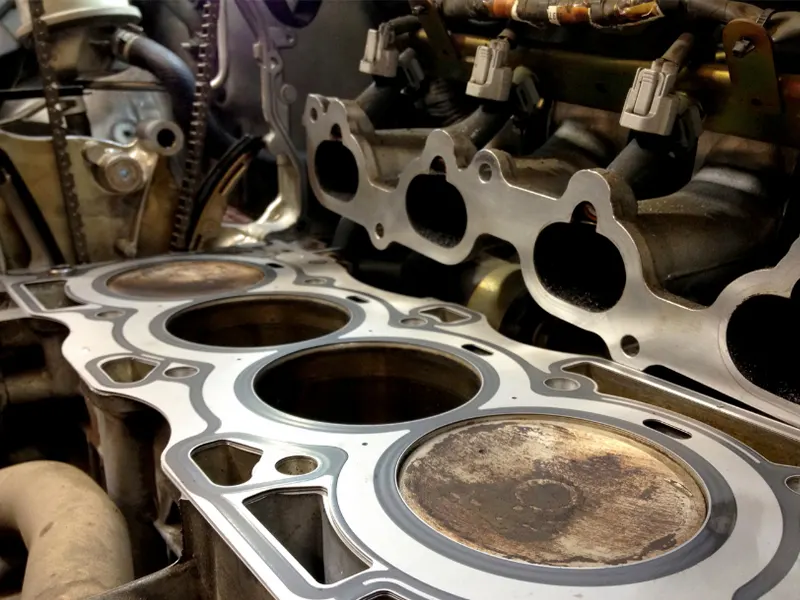Is it possible to repair a blown head gasket without a full replacement? Yes, in certain circumstances you can temporarily seal small head gasket leaks using a specially formulated chemical sealer. While not a permanent fix, these sealers can extend the life of a mildly failed gasket.
To understand if a sealer can help and how to use it properly, we’ll cover confirming you have a blown head gasket, preparing the cooling system, adding the right sealer correctly, final coolant refilling, and testing to ensure the repair holds. We’ll also discuss realistic expectations on sealer capabilities, when replacement is still required, and preventative steps to avoid a blowout. With an understanding of head gasket sealers, you can make an informed choice if trying this temporary repair route before resorting to a major overhaul.
Step 01: Diagnose the Problem Thoroughly
Confirming that you actually have a blown head gasket is crucial. A faulty thermostat, cracked engine block, or failed water pump can mimic some symptoms of a blown gasket. Verify the issue by checking for telltale signs like:
- White exhaust smoke or steam from the tailpipe indicating combustion gases entering the cooling system. Watch for exhaust gases bubbling in the radiator or coolant overflow tank.
- An oil contamination milkshake-like appearance from coolant mixing with engine oil.
- Overheating without other explainable causes. A blown gasket allows pressure to escape the combustion chamber.
- Check for external leaks around the cylinder head gasket surface. Coolant weeping can signal a breach.
Also identify what type of failure is occurring, whether it’s a blown head gasket causing an external leak, an internal leak allowing combustion gases to enter the coolant, or a combination. This helps determine if a sealer can adequately fix the specific problem.
Step 02: Prep the Cooling System for Chemical Sealing
With the gasket failure confirmed, flush the entire cooling system to clean out contaminants and residual coolant. Scale, rust and oil can interfere with sealers achieving a tight seal. Use a radiator flush additive following directions.
Refill the system with plain water once flushed. Sealer manufacturers often specify not using coolant because some types may react with chemical sealers in undesirable ways. Only water should be present when introducing the sealer.
Step 03: Add the Head Gasket Sealer
Follow the product’s instructions precisely when adding the sealer, especially for shake-well liquid types that require thorough mixing. Pouring into the radiator fill opening is common, then allowing the water pump to circulate it.
Idle the engine for the full time stated, often 30-90 minutes, if said sealer requires this heating and wetting duration to activate and take effect. Don’t cut this short. Proper curing time is crucial for the sealers to work as engineered and designed.
Step 04: Finish With a Fresh Coolant Fill
Once the prescribed sealing period passes, fully drain the water/sealer mixture out of the radiator. Refill again with fresh coolant/water mixture as normal to complete the job. This replaces now-spent sealing chemicals and resumes corrosion protection for the engine.
Step 05: Road Test to Confirm Repair Integrity
The true test comes from driving the vehicle for a few days, up to a week, monitoring engine vitals and watching for any symptoms. Hopefully the sealer treatment held, evidenced by a lack of overheating, no fluids mixing, and no observable leaks. Consider a follow-up scan with a block checker for combustion gases in the coolant if concerned. But if issues persist, the underlying blown gasket requires a proper replacement.
When used properly on minor failures, quality sealers can be a temporary fix and get more mileage out of a blown head gasket. But for severe leaks or warped mating surfaces, replacement is the more reliable repair option. Either way, always diagnose the root cause thoroughly.
Can I temporarily fix a blown head gasket?
Yes, in some cases you can temporarily fix a minor blown head gasket leak using a high-quality chemical sealer specifically designed for sealing gaskets. Follow directions closely and allow proper curing time. This can buy you some time before needing a full replacement. But sealers are not a permanent fix for all gasket failures.
Can you stop a head gasket from blowing?
It’s difficult to completely prevent a head gasket from eventually blowing with age and engine wear. But you can help extend its life by properly maintaining the cooling system, monitoring engine temperature, avoiding overheating, correcting other leaks that can hydrolock the cylinder, and repairing warped heads or blocks before reinstalling a new gasket.
Does head gasket repair liquid work?
Head gasket repair liquids can work to seal minor external coolant and internal combustion gas leaks if used properly. But results aren’t guaranteed. Severe leaks, warped mating surfaces, or degraded gaskets may not fully seal. Follow all directions for the best chance of success. Consider it a temporary fix, not a permanent gasket repair.

John Smith, a Los Angeles-based car specialist and automotive writer, boasts over 20 years in the industry. With a background as a master technician and a decade-long writing stint at notable automotive publications, John now shares his expansive knowledge on CarFinite, simplifying car maintenance for readers.

